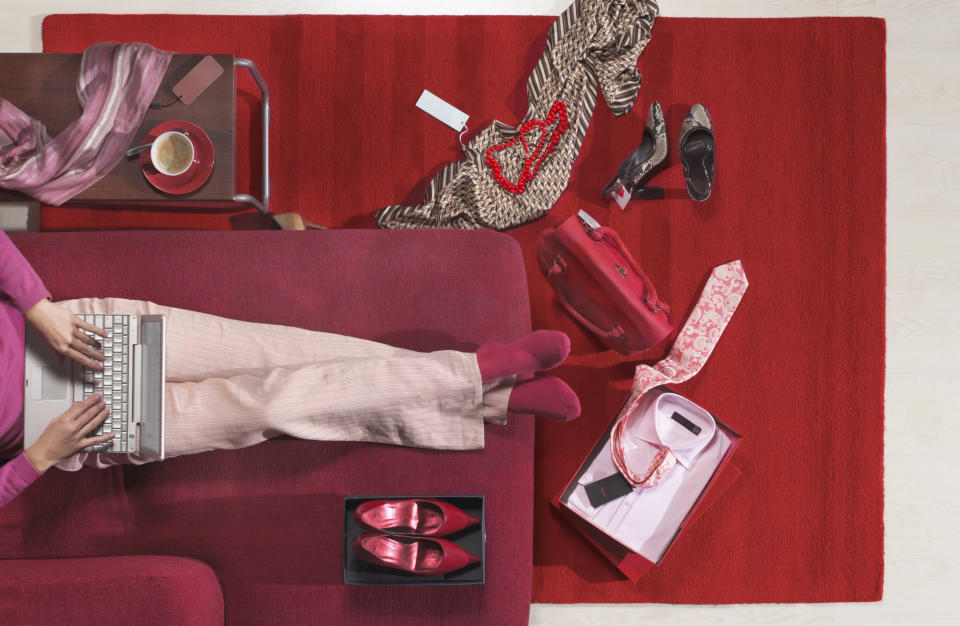The secret is out: How to make an easy fortune in Australia's most lucrative market place

Australia’s $34 billion second-hand economy is a lucrative market place for designer fashion labels often fetching five times their retail asking price.
Like many savvy shoppers, Gemma Crowe, who is the owner and designer of Infamous Swim has made a decent side income out of buying and selling select fashion items online, and often for much more than she paid for them.
“If it’s dead stock you can sell an item for 25 per cent more than the original recommended retail price, and that’s no kidding,” she said.
““If it’s dead stock you can sell an item for 25 per cent more than the original recommended retail price, and that’s no kidding.
“We have also had a lot of success with Jordan shoes, especially the shoes that are numbered from when Michael Jordan played his American basketball championships.”
“The dead stock of these items resell for crazy amounts five times the amount you can buy in store or more.”
Related content: Netflix has caused a flood of second-hand clothing
Related content: Your household rubbish could be worth $4,200
Related content: 6 ways to make money while you sleep
“But for some other designer items that are still available you would be looking at more like 25 per cent less for in new condition.”
What is dead stock? Dead stock means the item has been produced in a certain quantity and sold out meaning you can’t buy it from anywhere anymore except second hand sales avenues.
Over the past decade, the second hand economy has boomed helped by the rise of online platforms such Facebook Marketplace, Ebay and Gumtree, which allow everyday shoppers and retailers to trade items in a serious business sense or as a bit of a side hustle.
Crowe says from her experience, many women will spend anywhere between $150 – $400 a month on fashion, either from stores or second hand, totalling $1500-$4800 a year.
Designer items such as dresses, bags and shoes certainly hold their value best in the second hand economy, whereas fast fashion doesn’t really have a place.
“Sometimes holding on to those trending items is key, once a store/brand is sold out it becomes priceless,” says Crowe.
“People will pay whatever they can afford for an item that you cannot buy anymore,” she says.
Research by comparison website Finder shows that 35 per cent of Australians sell unwanted items on either Gumtree, eBay or at markets to make some extra cash.
Other research suggests that over 70 per cent of us could actually be sitting on a small fortune in unwanted clothing items in our wardrobes. Gumtree’s 2018 Second Hand Economy Report estimates that figure is around $4,200 per person.
“My own personal experience has seen brands like Sass and Bide, Christian Louboutin and Paul Smith sell well in the second hand market,” says Gumtree spokesperson Kirsty Dunn.
“I always try to keep the boxes and dust bags for my premium designer shoes as it ensures a higher resell value. There’s also plenty of demand for brands like Chanel, Hermes and Tiffany – all of which you could make a pretty penny for.”
Clothing, shoes and accessories are the top second hand item sold through Gumtree, making up 22 per cent of items sold online.
How you can get in on the action
Some of the tips for selling fashions in the second hand market include:
Hold on to the original packaging such as boxes and dust bags as these help to add to the value of certain designer items such as Louis Vuitton
Be honest about the condition of an item and whether it is original
Be clear about your terms, such as do you allow people to try items on first, or do you provide refunds
Keep your communications professional, and don’t get angry if someone changes their mind about an item
Be responsive in your communications
Crowe says that items that stand out or are a staple piece from a trending brand, fashion items that become icons to a brand will always hold their value, as well as pieces made from timeless materials such as leathers or gold embellishments.
“As a late teenager I was really into buying designer clothing items and re-selling, my sister and I actually made a small business out of it for a year or so,” Crowe said.
“We would re-search and buy highly sort after items from designer fashion brands or commonly purchased brands on eBay… and then either wear for one occasion, or not at all, and then re-sell in pristine condition.”
“Brands that are highly sort after or that are ‘trending’ are definitely something you should look at when purchasing for your own wardrobe or to re-sell.”
“Sass and bide and C&M were two of my favourite brands to research. We would buy and resell many of these items.”
Bianca Hartge-Hazelman is a regular columnist on women’s money matters for Yahoo Finance. She is the founder of women’s money blog Financy and the Women’s Index.
Make your money work with Yahoo Finance’s daily newsletter. Sign up here and stay on top of the latest money, property and tech news.

 Yahoo Finance
Yahoo Finance 